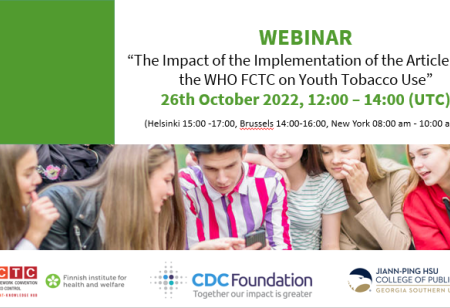
How to build upon surveillance to accelerate tobacco control? - 29 January 2020

Written by Dr. Indu Ahluwalia, PhD, MPH, the Chief of the Global Tobacco Control Branch in the Office on Smoking and Health of the U.S. Centers for Disease Control and Prevention.
How to build upon surveillance to accelerate tobacco control?
Globally, tobacco use kills more than eight million people per year. Through the Global Tobacco Surveillance System (GTSS), CDC provides technical assistance to countries to monitor the tobacco use epidemic and other tobacco-related indicators to assess progress, challenges, and opportunities for improvement. The GTSS is the global standard of systematically monitoring tobacco use (smoked, smokeless, electronic products, and new and emerging products) and related key tobacco control indicators for both youth and adults. Since 1999, CDC has worked with 188 countries/entities to conduct the Global Youth Tobacco Survey (GYTS). Since 2008, 32 countries have completed Global Adult Tobacco Surveys (GATS) through CDC’s technical assistance. Among the 181 Parties to the WHO FCTC, altogether 160 countries have conducted GYTS and 32 countries have completed GATS at least once thereby tracking tobacco use and key tobacco control indicators globally to inform tobacco control policies and programs.

Since 2009, 93 countries have integrated Tobacco Questions for Surveys (TQS) into adult national surveys to gather critical data on tobacco use and exposure. The newest component of GTSS, TQS-Youth, allows countries to integrate tobacco-related questions into youth surveys. The TQS and TQS-Youth are subsets of survey questions from the GATS core questionnaire and GYTS core questionnaire, respectively. TQS and TQS-Youth provide a standard set of survey questions with associated indicators on tobacco use and key tobacco control measures which can be integrated into any health, social, or other survey to obtain a comprehensive picture of tobacco control in any population of interest. Through these components, GTSS provides powerful data to inform country level tobacco control efforts.
Data generated by surveillance are the lifeblood of public health. GTSS is used to assess progress and to develop ongoing programmatic efforts to reduce tobacco use, secondhand smoke exposure, prevent youth initiation, and reduce exposures to tobacco marketing. A recently published article in the Morbidity and Mortality Weekly Report illustrates global partner’s progress in tobacco prevention and control. Across 11 countries with repeated GATS surveys, findings indicate that there were about 20 million fewer adults who use tobacco, about 50 million fewer adults exposed to secondhand smoke in public places, about 99 million fewer adults exposed to tobacco advertisements, promotions, and sponsorships, and about 12 million more adults thinking of quitting smoking because of health warning labels. These 11 countries are Parties to the WHO FCTC and cover large proportion of world’s tobacco users in low- and middle-income countries. Such information provides evidence of progress and can help facilitate the planning and execution of evidence-based tobacco control strategies to protect public health. The newly established GTSS Academy provides information and practical examples of the use of GYTS and GATS surveys on national and regional level and as such, it serves as a valuable resource for the Parties to the WHO FCTC.
Unfortunately, progress in tobacco prevention and control is not uniform across countries. While some countries have made significant strides in multiple areas, opportunities exist for improvement across all countries. These opportunities include strengthening and enforcing the demand reduction measures outlined by the WHO FCTC. The WHO’s Global Action Plan for the Prevention and Control of Noncommunicable Diseases (NCDs) encourages countries to aim for a 30% relative reduction in tobacco use from their baseline prevalence by 2025. Specifically, the target 3.4 in the United Nation’s Sustainable Development Goals (SDGs) aims for reductions in premature mortality due to NCDs by third by 2030, and the target 3.a aims to decreased tobacco use through strengthened implementation of the WHO FCTC. Surveillance data from GTSS can help assess global and country level progress toward these goals.
Global collaboration and effective partnerships are key to facilitating sustained efforts to combat the tobacco use epidemic. The WHO is a critical partner for GTSS surveillance. The United States Centers for Disease Control and Prevention’s (CDC) global tobacco program is designated as a WHO collaborating center for tobacco surveillance. The CDC actively collaborates with the Convention Secretariat of the WHO FCTC and works directly with many Parties in collaboration with WHO to strengthen their implementation of the Article 20 of the WHO FCTC, and to monitor the progress in the global targets, with data from GTSS surveys. The surveillance data from the GTSS can be useful for the WHO FCTC Secretariat’s Knowledge Hub’s work in assisting Parties to meet their responsibilities under the WHO FCTC.
The ever-changing tobacco landscape threatens progress made by countries on key tobacco control indicators, such as tobacco use and exposure to secondhand smoke, and presents both challenges and potential opportunities. Components of GTSS remain intentionally flexible by allowing systematic surveillance of new and emerging products, such as e-cigarettes and heated tobacco products. Assessing tobacco control progress with credible data, which are comparable over time within and across countries, can inform strategies to counteract the global tobacco epidemic. Cultivating and sustaining tobacco surveillance global partnerships is a key step in assessing tobacco control progress and identifying opportunities for improvement.
After all, what gets measured gets done!
About the author:
Indu Ahluwalia, PhD, MPH
U.S. Centers for Disease Control and Prevention
Dr. Ahluwalia is the Chief of the Global Tobacco Control Branch in the Office on Smoking and Health. She is responsible for guiding the scientific work of the branch, including tobacco surveillance, translation of data to usable information, and providing technical assistance for capacity enhancement.
Dr. Ahluwalia has been with CDC since 1995 when she joined the Epidemic Intelligence Service. From 2008 until she joined Office on Smoking and Health in 2015, Dr. Ahluwalia served as a Senior Scientist in the Division of Reproductive Health where she provided leadership to the PRAMS team and led projects with the March of Dimes and W.K. Kellogg Foundation. Her work building and sustaining partnerships has resulted in key improvements in using public health surveillance data to address gaps in services and programs.
Dr. Ahluwalia has a PhD in Health Behavior and Health Education from the University of North Carolina, at Chapel Hill and an MPH in Epidemiology and International Health from Yale University.





